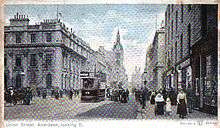Aberdeen Corporation Tramways
Aberdeen Corporation Tramways formerly served the City of Aberdeen, Scotland.
| Aberdeen Corporation Tramways | |
|---|---|
 Tram 34 on Union Street, Aberdeen ca. 1900 | |
| Operation | |
| Locale | Aberdeen |
| Open | 27 August 1898 |
| Close | 3 May 1958 |
| Status | Closed |
| Infrastructure | |
| Track gauge | 1,435 mm (4 ft 8 1⁄2 in) |
| Propulsion system(s) | Electric |
| Statistics | |
| Route length | 16.12 miles (25.94 km) |
The system
The city's tram system was the most northerly municipal tramway in the United Kingdom. From 1906 to 1918 the system fell under the care of R. S, Pilcher who served as General Manager and Chief Engineer.[1]
The system was electrified, with trams using the standard trolley poles until 1935 when bow collectors were fitted to take power from the overhead wires. The trams were double deck and painted in a dark green and cream livery, often with the words "CORPORATION TRANSPORT" painted prominently on the sides.
In the late 1930s the city purchased 18 trams from Nottingham Corporation Tramways, which closed in 1936. Further secondhand trams were later obtained from Manchester. The last new trams for the city were built by R Y Pickering of Wishaw in 1949.
The city's best known service was route 1, from Bridge of Don to Bridge of Dee, the numbering of which is preserved by the current number 1 bus service serving the same areas. The city's last tram operated on 3 May 1958, being replaced by diesel buses.
A short stretch of track that served as a terminus for the Sea Beach route remains alongside the Beach Boulevard where, following their final day in service, the entire fleet was burned.[2] This remainder formerly ran right across to the former Constitution Street depot (now Aberdeen Science Centre), however the western end is now occupied by a hotel.
| No. | From | To | Via | Notes |
|---|---|---|---|---|
| 1 | Bridge of Dee | Bridge of Don | Union Street | |
| 2 | Castle Street | Mannofield | Great Western Road | |
| 3 | Castle Street | Castle Street | Union Street, Queen's Cross, Fountainhill Road, Rosemount Place, Rosemount Viaduct and Union Terrace | Circular Route |
| 4 | Castle Street | Hazlehead | Queen's Road | |
| 5 | Castle Street | King's Gate | Union Terrace | |
| 6 | Castle Street | Castle Street | Union Terrace, Rosemount Viaduct, Rosemount Place, Fountainhill Road, Queen's Cross and Union Street | Circular Route |
| 7 | St Nicholas Street | Woodside and Scatterburn | George Street and Great Northern Road | |
| 9 | Castle Street | Sea Beach | Constitution Street |
The tram system was supported by 14 bus routes numbered No. 4, No. 8 and No. 11 through to No. 22, No. 4 being an extension of the No. 4 tram route.
Depot
There was a tram depot at Queen's Cross (grid reference NJ 92362 05887). The building was purchased by Grampian Television in 1960 and converted into their television studios and headquarters. In 2003 Grampian Television relocated their studios and offices to new premises; the former tram depot was subsequently demolished and new flats built on the site.
Successors
Following the closure of the tram system, Aberdeen Corporation continued to operate buses. Following the Local Government (Scotland) Act 1973, the fleet passed to the new Grampian Regional Council in 1975, becoming Grampian Regional Transport. The dark green and cream livery was retained. Following the Transport Act 1985 the company was subsequently privatised, becoming the GRT Group, which later became FirstGroup. As of 2009, buses in Aberdeen are operated by First Aberdeen.
There were proposals for a new tramway system in 2013, but they were rejected in September 2014.
See also
References
- Biographical Index of Former Fellows of the Royal Society of Edinburgh 1783–2002 (PDF). The Royal Society of Edinburgh. July 2006. ISBN 0 902 198 84 X. Archived from the original (PDF) on 4 March 2016. Retrieved 30 December 2017.
- Paton, Craig; Morrice, Emma. "Watch: Focus on Aberdeen trams 60 years after their service ended". Evening Express. Retrieved 1 July 2019.